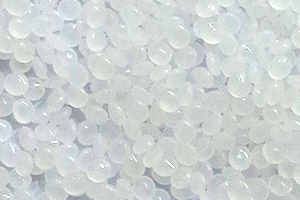Polyethylene(PE)

By far the most popular thermoplastic commodity used in consumer products (especially products created by rotational moulding), polyethylene is created through the polymerization of ethylene (i.e., ethene).
Chemical CompositionThe ethylene molecule is C2H4 (CH2=CH2)
Ethylene Monomer
Ethylene Polyethylene Polymer
Polyethylene Polymer A.K.A.Polyethene, Polythene, PE, LDPE, HDPE, MDPE, LLDPE
LDPELDPE (Low Density Polyethylene) is defined by a density range of 0.910 - 0.940 g/cm3. It has a high degree of short and long chain branching, which means that the chains do not pack into the crystal structure as well. It has therefore less strong intermolecular forces as the instantaneous-dipole induced-dipole attraction is less. This results in a lower tensile strength and increased ductility. LDPE is created by free radical polymerization. The high degree of branches with long chains gives molten LDPE unique and desirable flow properties.
HDPEHDPE (High Density Polyethylene) is defined by a density of greater or equal to 0.941 g/cm3. HDPE has a low degree of branching and thus stronger intermolecular forces and tensile strength. HDPE can be produced by chromium/silica catalysts, Ziegler-Natta catalysts or metallocene catalysts. The lack of branching is ensured by an appropriate choice of catalyst.
MDPE (Medium Density Polyethylene) is defined by a density range of 0.926 - 0.940 g/cm3. MDPE can be produced by chromium/silica catalysts, Ziegler-Natta catalysts or metallocene catalysts.
LLDPE (Linear-Low Density Polyethylene) is defined by a density range of 0.915 - 0.925 g/cm3. is a substantially linear polymer, with significant numbers of short branches, commonly made by copolymerization of ethylene with short-chain alpha-olefins (e.g. 1-butene, 1-hexene, and 1-octene).
Source: Wikipedia.org
PropertiesLDPE Properties:
Semi-rigid, translucent, very tough, weatherproof, good chemical resistance, low water absorption, easily processed by most methods, low cost.
LDPE Physical Properties: Value:
Tensile Strength: 0.20 - 0.40 N/mm2
Notched Impact Strength: no break
Thermal Coefficient of Expansion: 100 - 220 x 10-6
Max. Continued Use Temperature: 65 oC (149 oF)
Melting Point: 110 oC (230 oF)
Glass Transition Temperature: -125 oC (-193 oF)
Density: 0.910 - 0.940 g/cm3
HDPE Properties:
Flexible, translucent/waxy, weatherproof, good low temperature toughness (to -60C), easy to process by most methods, low cost, good chemical resistance.
HDPE Physical Properties: Value:
Tensile Strength: 0.20 - 0.40 N/mm2
Notched Impact Strength: no break
Thermal Coefficient of Expansion: 100 - 220 x 10-6
Max. Continued Use Temperature: 65 oC (149 oF)
Melting Point: 126 oC (259 oF)
Density: 0.941 - 0.965 g/cm3